Mot, Verizon announce Android phone
Oct 28, 2009 — by Eric Brown — from the LinuxDevices Archive — 25 viewsVerizon Wireless announced its first Android phone, built by Motorola. Due to ship Nov. 6 for $200, the slider-based “Droid” offers a 550MHz ARM Cortex-A8 processor, a 3.7-inch touchscreen, a five-megapixel camera, voice recognition, and Google Maps Navigation with turn-by-turn voice guidance.
The much anticipated Droid, previously code-named Sholes and Tao, and now formally dubbed "Droid by Motorola," has been repeatedly tipped on the web, and was pre-announced with a Verizon advertising campaign almost two weeks ago that appeared to blast the Apple iPhone for being an "iDon't" phone.
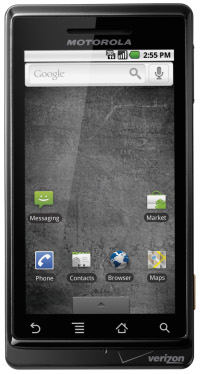
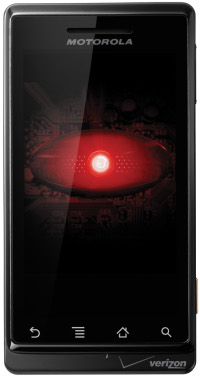
Droid by Motorola
(Click on either to enlarge)
The Droid is Verizon Wireless' first Android phone and Motorola's second, after the T-Mobile-sold Cliq. According to various reports, Motorola is prepping more Android phones, including a Zeppelin phone that appears to be aimed at China, as well as a Verizon-destined Calgary phone that looks to be a scaled down version of the Droid.
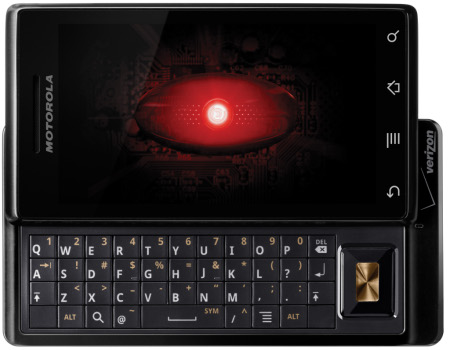
The Droid with slider extended
(Click to enlarge)

Droid from behind, showing camera
The Droid is also the first phone to run Android 2.0 (Eclair), which was released by the Google-sponsored Android project late yesterday. Android 2.0 adds new APIs for sync and contact management functions, among other features.
Cortex-A8 processor boosts multitasking
The Droid is claimed by Verizon to have raised the bar on multi-tasking among Android phones, allowing seamless juggling of up to six applications. Although this may be tied in part to enhancements made in Android 2.0, it appears to be mostly due to the phone's "550MHz ARM Cortex-A8 based processor," as Motorola describes it.
The BoyGeniusReport says the Droid's processor is a Texas Instruments OMAP3430 system-on-chip (SoC), the same SoC that has been used in several recent smartphones, including the Palm Pre and the Nokia N900. The Droid includes a microSD expansion slot and ships with a preinstalled 16GB memory card, according to Motorola.
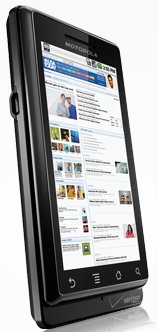
The Droid at an angle
A five-megapixel camera offers dual-LED flash, autofocus, and image stabilization, and supports DVD-quality video capture and playback, says the company. Accelerometers and sensors round out the top-of-the-line feature list (see spec list below).
The six-ounce, 2.4 x 4.6 x 0.5-inch device is claimed to be the thinnest Android phone with a QWERTY slider. The keyboard is augmented with a directional navigation key with center select, as well as other dedicated keys for features such as the camera, volume control, and search. The 1400 mAh battery offers up to 385 minutes of usage, claims Motorola.
Google Maps Navigation debuts
The Droid lacks the innovative "MotoBlur" social networking UI layer and online network provided for the Motorola Cliq, but it offers Android 2.0's expanded feature set, as well as a full line-up of Google's mobile apps, including a first: the beta of the new Google Maps Navigation (Beta).
The new nav app offers turn-by-turn voice guidance as a free feature of Google Maps, and provides voice shortcuts such as "Navigate to [your destination]," says Verizon. Other features are said to include the ability to see live traffic, use Street View or satellite imagery to view a route, or get access to recent maps and business information from Google Maps, updated over the air.
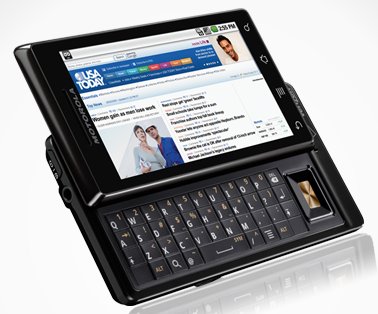
The Droid showing Android's updated WebKit browser
Other software features include sync support for calendar, email, and contacts (Exchange 2003 and 2007). A new Android notification panel is said to improve message handling, and a smart dictionary learns from user behavior and automatically includes contact names.
Specifications listed for the Droid by Motorola include:
- Processor — 550MHz ARM Cortex-A8 based CPU (likely the TI OMAP3430)
- Memory — n/s
- Expansion — microSD slot accepts up to 32GB; phone comes with 16GB card
- Display — 3.7-inch WVGA (854 x 480) touchscreen; 400,000 pixels; 16:9 aspect ratio; backlight and light-response
- Cellular — CDMA 1X 800/1900, EVDO rev A
- WiFi — 802.11b/g
- Bluetooth — Stereo Bluetooth v2.1 + EDR
- GPS — aGPS (assisted); sGPS (simultaneous)
- USB — 1 x Micro USB 2.0
- Camera — 5 megapixel; 4x digital zoom; dual LED flash; autofocus
- Video — DVD quality (720 x 480) capture at up to 24fps; playback at up to 30fps
- Audio — Music player; 3.5mm headset jack
- Dedicated keys — Navigational key, volume control, camera, back, search, menu, power/lock, home
- Other hardware features:
- Slide-out QWERTY keyboard
- Accelerometer
- Proximity, ambient light, and eCompass sensors
- Haptic feedback
- Software (condensed list):
- Web browser (WebKit HTML5)
- Email (Exchange 2003 and 2007, Gmail, IMAP, POP3, Office and PDF viewers)
- Messaging (MMS, SMS, Google Talk)
- Voice mail
- Google apps, including new Google Maps Navigation beta
- Speech recognition
- Unified contact list
- Speakerphone and other dialing features
- Facebook, YouTube, Amazon MP3 Store integration
- Battery — 1400 mAh Li Ion; up to 385 minutes talk time; up to 270 hours standby
- Dimensions — 2.4 x 4.6 x 0.5 inches (60 x 115.8 x 13.7mm)
- Weight — 6 oz. (169g)
- Operating system — Android 2.0
Stated Sanjay Jha, co-chief executive officer of Motorola and CEO of Motorola Mobile Devices, "Droid by Motorola delivers a rich consumer experience with warp-speed Web browsing, a mammoth screen, and Motorola's expertise in design and voice quality."
Stated John Stratton, EVP and CMO for Verizon Wireless, "Droid by Motorola gives customers a lifestyle device with access to more than 12,000 applications that will help them stay in touch, up to date and entertained, using the best 3G network in the country."
Availability
The Droid by Motorola will be available in the U.S. exclusively at Verizon Wireless Communications Stores and online on Friday, Nov. 6, for $200 with a new two-year customer agreement after a $100 mail-in rebate, says Verizon Wireless. Nationwide voice plans are said to start at $40 for monthly access for 450 minutes, and an "Email and Web for Smartphone" plan costs $30 for monthly access.
More information on the Droid may be found at the Verizon page, here, and much more can be found at the Motorola page, here.
An eWEEK story on Google Maps Navigation may be found here.
This article was originally published on LinuxDevices.com and has been donated to the open source community by QuinStreet Inc. Please visit LinuxToday.com for up-to-date news and articles about Linux and open source.